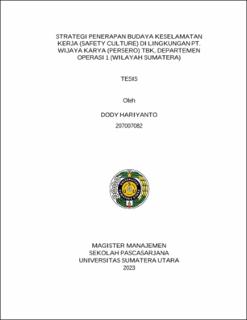| dc.description.abstract | Safety culture is a concept defined at a group level or higher that refers to shared values
between all groups or companies, corporations or organizational members. Safety culture deals
with formal safety issues within an organization and is closely linked to, but not limited to,
management and control systems. Safety culture emphasizes the contribution of everyone at
every level of the organization. In business entities this has an impact on the behavior of all
members of the workforce in the workplace which is usually reflected in the relationship between
the reward system and safety performance. This study examines how much the Regulatory
factors and Management Commitment can affect the implementation of safety culture, as well as
what strategies can be proposed to improve safety culture. The research was conducted in PT.
Wijaya Karya (Persero) Tbk Operations Department 1 Sumatra Region with The Explanatory
Sequential Design method or known as the two-phase method where quantitative data as the first
phase is used as a basis and qualitative data as the second phase for supporting, or in other
words a quantitative approach is a top priority which is supported by a qualitative approach
(Sinulingga, 2021), Qualitative research using a Likert questionnaire was conducted on 44
employees from various positions, as well as qualitative interviews as support for the 4 selected
employees. From the results of the study it was found that regulation and management
commitment have an important influence on safety culture, both partially and collectively.
However, the most positive and significant influence is the Management Committee.
Furthermore, from the interview results, several conditions were found in the implementation of
Occupational Health and Safety Management (OHSM) which could be part of a strategy to build
a safety culture, including: (1) Making regulations that are right on target, (2) Creating role
models as role models and role models, (3) Creating the involvement of all parties , (4)
Knowledge Management in the implementation area of OHSM, (5) Communication and
socialization of programs, (6) Selection of resources in the field of safety, (7) Implementation of
transparent and fair reward and punishment in implementing OHSM. This strategy can work
well if management is fully committed to making safety culture a part of the corporate culture.
Without this, inconsistencies and tolerances for deviations will arise, which if left unchecked will
hinder or possibly thwart the process of creating the expected safety culture. | en_US |


